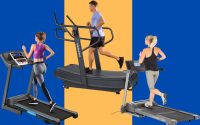The best exercises to reduce blood pressure — planks, wall sits
Don’t move a muscle.
There’s plenty of medical advice on how to lower your blood pressure — exercise is right at the top of the list, along with a healthy diet, losing weight and quitting smoking.
But new research reveals which types of exercise might be most effective — and it’s probably not what you think.
The study, published in the British Journal of Sports Medicine, showed that isometric exercises — in which a person holds one position without moving — may be better than cardio.
In particular, strength training staples like planks and wall sits were noted for their effectiveness at controlling high blood pressure, also called hypertension.
“Performing 4 x 2 minutes of wall sits, with two-minutes’ rest in between, three times per week, is an effective way to reduce your blood pressure,” Dr. Jamie O’Driscoll, a cardiovascular physiologist at Canterbury Christ Church University and lead author of the report, told the Guardian.

“They should be done alongside other exercise modes,” O’Driscoll added, “to provide the maximum range of exercise choices rather than limiting them.”
Exercising for specific health reasons has been advised for years, but most recommendations have focused on aerobic, or cardio exercises such as running, cycling and swimming.
Those recommendations are often based on older research that excludes newer, more fashionable ways to get fit, such as high-intensity interval training and isometric exercise.

To update the information on exercise effectiveness, the team of researchers combed through 270 reports published between 1990 and February 2023, with a total data sample of 15,827 participants.
They grouped exercise into five categories — aerobic, dynamic resistance training, a combination of those, HIIT or isometric exercise.
Analysis revealed that all of the categories helped lower both systolic and diastolic blood pressure.
Systolic blood pressure, the first number in a blood pressure reading, measures blood pressure when the heart beats, while diastolic blood pressure, the second number, measures blood pressure between heartbeats.
However, the largest drops in both systolic and diastolic blood pressure were achieved after the isometric exercise training. Running was found to be nearly as effective.
Meanwhile, HIIT, a demanding form of exercise involving short bursts of intense exercise, was found to be the least effective at lowering systolic blood pressure.
Not all medical experts, however, agree researchers have found the key to lowering blood pressure for all people.
“The reality is, a significant proportion of the population will not be able to do a plank or wall sits, and furthermore may not enjoy these types of activities,” Dr. Kush Joshi, a sports and exercise medicine consultant, told a reporter.
“Solutions need to be found to make these exercises accessible to all individuals with elevated blood pressure, and the study should provide impetus to policymakers to make exercise the bedrock of treatment of not only high blood pressure but other medical conditions,” he said.


